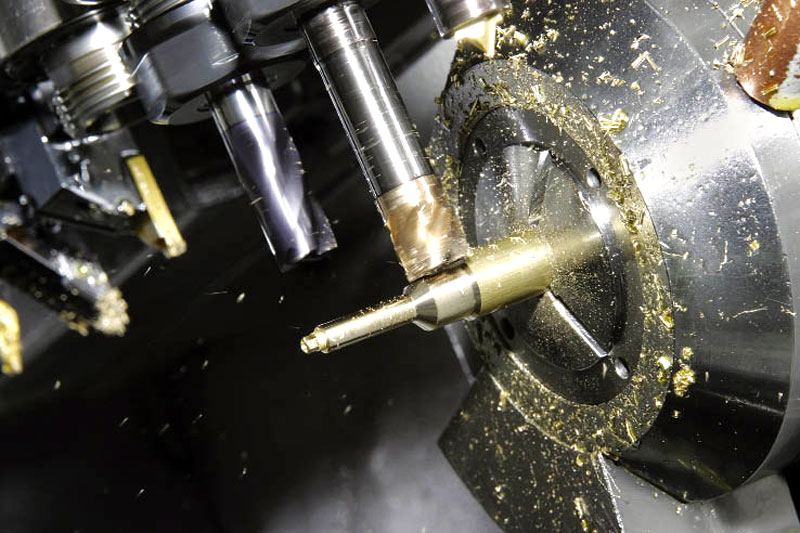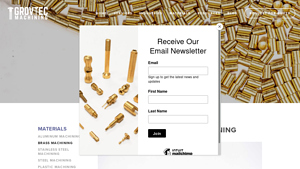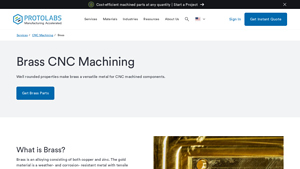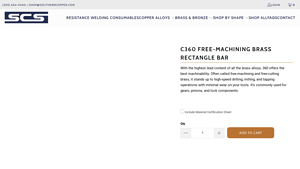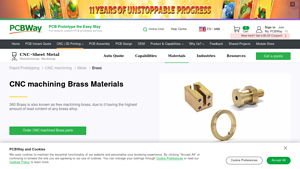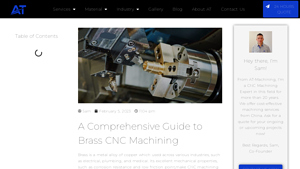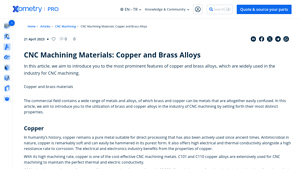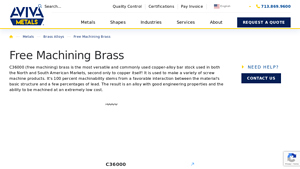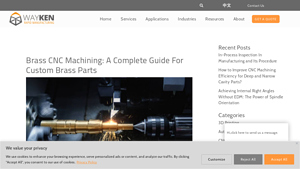Machinable Brass Guide: Type, Cost, Top List…
Introduction: Navigating the Global Market for machinable brass
Navigating the complexities of sourcing machinable brass can pose significant challenges for international B2B buyers, especially those operating in emerging markets like Africa, South America, the Middle East, and Europe. With a myriad of brass grades available—each varying in composition, machinability, and application—making informed purchasing decisions is crucial. This guide is designed to demystify the global market for machinable brass, providing insights into the different types of brass, their specific applications across various industries, and key factors to consider when vetting suppliers.
The comprehensive scope of this guide covers essential topics such as the unique properties of various brass grades, cost considerations, and best practices for procurement. By exploring these elements, buyers will gain a deeper understanding of how to select the right brass for their projects, ensuring they meet both performance and budgetary requirements.
Moreover, this resource aims to empower B2B buyers by equipping them with actionable insights and strategies to navigate the complexities of international sourcing. Whether you’re in need of brass for plumbing, electronics, or decorative applications, this guide serves as an authoritative reference to enhance your purchasing strategy and secure reliable partnerships in the global market.
Understanding machinable brass Types and Variations
| Type Name | Key Distinguishing Features | Primary B2B Applications | Brief Pros & Cons for Buyers |
|---|---|---|---|
| C200 Brass | High copper content (95-99%), excellent corrosion resistance | Plumbing fixtures, electrical components | Pros: Superior corrosion resistance, good electrical conductivity. Cons: Higher cost, more challenging to machine. |
| C210 Brass | Known as Gilding Metal, 95% copper, excellent formability | Jewelry, decorative fittings | Pros: Easy to work with, attractive appearance. Cons: Limited strength compared to other alloys. |
| C220 Brass | Contains 90% copper, 10% zinc, good ductility and strength | Marine hardware, automotive components | Pros: Good balance of strength and machinability. Cons: Moderate corrosion resistance compared to higher copper grades. |
| C360 Brass | Free-machining alloy with excellent machinability | Precision parts, fasteners | Pros: Exceptional machinability, cost-effective. Cons: Lower corrosion resistance than other brass types. |
| C230 Brass | High corrosion resistance, 85% copper, 15% zinc | Oil and gas fittings, plumbing | Pros: Good strength and formability. Cons: Higher cost and reduced machinability. |
What are the Key Characteristics of C200 Brass and Its B2B Suitability?
C200 brass, known for its high copper content ranging from 95% to 99%, excels in environments requiring corrosion resistance. This makes it suitable for applications such as plumbing fixtures and electrical components. Buyers should consider the higher costs associated with this alloy, as well as its machinability challenges, which may necessitate specialized machining processes for intricate designs.
How Does C210 Brass Stand Out in Decorative Applications?
C210 brass, or Gilding Metal, is primarily composed of 95% copper, offering excellent formability and a distinctive reddish hue. This alloy is ideal for decorative applications, such as jewelry and ornamental fittings. While its aesthetic appeal is a strong selling point, buyers should be aware of its relatively lower strength, which may limit its use in high-stress environments.
Why Choose C220 Brass for Marine and Automotive Industries?
C220 brass, consisting of 90% copper and 10% zinc, strikes a balance between ductility and strength, making it versatile for marine hardware and automotive components. Its moderate corrosion resistance is a consideration for buyers, especially in environments exposed to saltwater or chemicals. However, its good machinability allows for efficient production of complex parts.
What Makes C360 Brass a Preferred Choice for Precision Parts?
C360 brass is recognized for its free-machining properties, making it highly suitable for precision parts and fasteners. Its excellent machinability translates to lower production costs, appealing to manufacturers focused on efficiency. However, buyers should note that C360 brass has lower corrosion resistance compared to other brass grades, which may affect its longevity in certain applications.
In What Situations is C230 Brass Most Beneficial?
C230 brass, containing 85% copper and 15% zinc, is known for its high corrosion resistance and formability. It is commonly used in oil and gas fittings and plumbing applications where durability is crucial. Buyers should weigh the benefits of its strength against its higher cost and reduced machinability, which may require more sophisticated machining techniques.
Key Industrial Applications of machinable brass
| Industry/Sector | Specific Application of machinable brass | Value/Benefit for the Business | Key Sourcing Considerations for this Application |
|---|---|---|---|
| Plumbing | Manufacturing of faucets and valves | High corrosion resistance ensures durability and longevity. | Ensure compliance with local plumbing standards and regulations. |
| Electrical & Electronics | Production of connectors and terminals | Excellent electrical conductivity enhances performance and reliability. | Source from suppliers with certifications for quality assurance. |
| Automotive | Fabrication of radiator cores and fittings | Good heat transfer properties improve vehicle efficiency. | Verify compatibility with specific automotive standards. |
| Medical Devices | Components for surgical instruments and dental tools | Biocompatibility and ease of cleaning are critical for safety. | Ensure compliance with medical industry regulations and certifications. |
| Decorative Applications | Creation of ornamental fixtures and awards | Aesthetic appeal and resistance to wear enhance product value. | Consider custom design capabilities and finish quality. |
How is Machinable Brass Utilized in Plumbing Applications?
In the plumbing sector, machinable brass is extensively used for manufacturing faucets, valves, and fittings. Its high corrosion resistance makes it ideal for environments exposed to moisture and various chemicals, ensuring long-lasting performance. For B2B buyers, especially in regions like Africa and South America, it is crucial to source brass that meets local plumbing regulations and quality standards to avoid costly replacements or repairs.
What Role Does Machinable Brass Play in Electrical and Electronics?
Machinable brass is a preferred material for producing connectors and terminals in the electrical and electronics industry due to its excellent electrical conductivity. This property allows for efficient power transmission and minimizes energy loss, which is essential for high-performance electronic devices. Buyers in the Middle East and Europe should prioritize sourcing from suppliers that provide certified materials to ensure reliability and compliance with industry standards.
How is Machinable Brass Used in Automotive Applications?
In the automotive industry, machinable brass is commonly used in the fabrication of radiator cores and fittings. Its good heat transfer properties contribute to overall vehicle efficiency and performance. For international B2B buyers, particularly in regions like Vietnam and Nigeria, it is vital to verify that sourced materials comply with automotive standards to ensure compatibility and safety in their applications.
What are the Applications of Machinable Brass in Medical Devices?
Machinable brass finds critical applications in the medical field, particularly in surgical instruments and dental tools. Its properties, such as biocompatibility and ease of sterilization, are essential for maintaining safety and hygiene in medical environments. Buyers must ensure that the brass components meet stringent medical regulations and certifications to guarantee patient safety and product efficacy.
How is Machinable Brass Leveraged in Decorative Applications?
In decorative applications, machinable brass is utilized for creating ornamental fixtures and awards, valued for its aesthetic appeal and resistance to wear. The material’s ability to be intricately shaped allows for unique designs that enhance product value. For B2B buyers, sourcing from suppliers that offer custom design capabilities and high-quality finishes can significantly impact the overall marketability of their decorative products.
3 Common User Pain Points for ‘machinable brass’ & Their Solutions
Scenario 1: Difficulty in Sourcing Quality Machinable Brass Grades
The Problem:
B2B buyers often face challenges in sourcing high-quality machinable brass grades suitable for their specific applications. With numerous grades available, it can be overwhelming to determine which grade offers the right combination of machinability, strength, and corrosion resistance. Buyers from regions like Africa and South America may encounter additional hurdles, such as limited access to suppliers who can provide reliable certifications for the brass grades, leading to concerns about material integrity and performance in critical applications.
The Solution:
To overcome sourcing difficulties, buyers should begin by clearly defining their project requirements, including specific mechanical and chemical properties needed for their applications. Engaging with reputable suppliers who specialize in machinable brass can provide insights into the best grades available for your needs. Additionally, requesting samples or test certificates for specific grades, such as C36000 for its free machining properties or C20000 for its corrosion resistance, can ensure that the materials meet the required standards. Establishing long-term relationships with suppliers who have a proven track record in delivering quality brass can also facilitate more reliable sourcing, ensuring that your projects proceed without material-related delays.
Scenario 2: Challenges in Machining Machinable Brass Components
The Problem:
Machining brass components can sometimes lead to unexpected difficulties, particularly when dealing with harder grades or intricate designs. Issues such as tool wear, inconsistent finish quality, and dimensional inaccuracies can plague manufacturers, causing delays and increased costs. For companies in the Middle East or Europe, where precision manufacturing is critical, these challenges can impact overall production efficiency and product quality.
The Solution:
To address machining challenges, it is essential to select the right tools and machining parameters for the specific brass grade being used. For example, using high-speed steel (HSS) or carbide tools can significantly enhance performance when machining tougher brass grades. Additionally, employing optimal cutting speeds and feeds tailored to the specific grade can help reduce tool wear and improve surface finish. Implementing a rigorous quality control process, including regular inspections and adjustments, can also ensure that machined components meet the desired specifications. Training operators on best practices for machining brass can further enhance efficiency and product quality, ultimately reducing production costs.
Scenario 3: High Costs Associated with Machinable Brass Components
The Problem:
The rising costs of raw materials, including machinable brass, can pose significant challenges for B2B buyers, especially those in competitive markets. Buyers may struggle to maintain their profit margins while ensuring the quality of their products, leading to tough decisions about material choice and sourcing strategies. This issue is particularly pronounced in developing markets where budget constraints are common.
The Solution:
To mitigate the impact of rising costs, buyers should explore alternative brass grades that offer a balance between performance and cost. For instance, considering lower copper content grades, such as C22000, can provide satisfactory machinability and strength at a reduced price. Additionally, buyers should leverage bulk purchasing agreements to negotiate better rates with suppliers, allowing for cost savings on larger orders. Implementing lean manufacturing principles to optimize production processes can also reduce waste and lower overall costs. Finally, conducting a thorough market analysis can help identify potential alternative materials or suppliers that offer competitive pricing without compromising quality, ensuring that buyers can maintain their profitability while still meeting customer demands.
Strategic Material Selection Guide for machinable brass
What Are the Key Properties of Common Machinable Brass Materials?
Machinable brass is available in various grades, each with unique properties that influence their performance in diverse applications. Understanding these properties is crucial for B2B buyers looking to make informed decisions.
C36000 Brass: The Free Machining Brass
C36000, or free machining brass, is one of the most popular grades for CNC machining due to its excellent machinability. It typically contains about 61% copper and 35% zinc, along with small amounts of lead, which enhance its cutting properties.
Key Properties: C36000 offers good corrosion resistance and can withstand moderate temperatures and pressures. Its machinability rating is among the highest, making it suitable for complex shapes.
Pros & Cons: The primary advantage of C36000 is its ease of machining, which leads to lower manufacturing costs and shorter lead times. However, its lead content can limit its use in certain applications due to health regulations, particularly in regions with stringent environmental standards.
Impact on Application: This grade is commonly used in the manufacturing of precision components such as fittings, valves, and screws. Its compatibility with various media makes it suitable for plumbing and electrical applications.
Considerations for International Buyers: Buyers from regions like Africa and South America should be aware of local regulations regarding lead content. Compliance with standards such as ASTM B16 and JIS H3250 is essential for market acceptance.
C26000 Brass: The Commercial Bronze
C26000, known as commercial bronze, comprises approximately 70% copper and 30% zinc. This alloy is recognized for its good mechanical properties and corrosion resistance.
Key Properties: C26000 exhibits excellent ductility and can withstand higher temperatures compared to other brass grades. It is also resistant to corrosion in marine environments.
Pros & Cons: The key advantage of C26000 is its versatility across various applications, from marine to electrical. However, its higher cost relative to other brass grades may deter some buyers, especially in price-sensitive markets.
Impact on Application: C26000 is ideal for applications requiring strength and corrosion resistance, such as marine hardware and electrical connectors.
Considerations for International Buyers: Compliance with international standards like ASTM B283 is crucial for ensuring product quality and acceptance in global markets. Buyers should also consider the availability of this grade in their local markets.
C21000 Brass: The Gilding Metal
C21000, or gilding metal, contains about 95% copper and 5% zinc. It is renowned for its deep red color and excellent formability.
Key Properties: C21000 offers high electrical conductivity and good corrosion resistance, making it suitable for decorative applications and electrical components.
Pros & Cons: The primary advantage of C21000 is its aesthetic appeal and conductivity. However, it is less durable than other brass grades, which may limit its use in high-stress applications.
Impact on Application: This grade is often used in decorative items, jewelry, and electrical contacts, where appearance and conductivity are prioritized.
Considerations for International Buyers: Buyers should be aware of the specific applications for which C21000 is suitable and ensure compliance with local standards, particularly in regions with strict regulations on electrical components.
C22000 Brass: The Commercial Brass
C22000, or commercial brass, consists of approximately 90% copper and 10% zinc. It is characterized by its good strength and corrosion resistance.
Key Properties: C22000 offers moderate machinability and is suitable for various applications requiring a balance of strength and formability.
Pros & Cons: The advantage of C22000 is its broad applicability across industries, including plumbing and automotive. However, its machinability is lower than that of C36000, which may increase manufacturing complexity.
Impact on Application: C22000 is used in plumbing fittings, automotive parts, and various industrial applications.
Considerations for International Buyers: Buyers should consider the specific requirements of their applications and local compliance standards, such as ASTM B36, to ensure suitability and acceptance in their markets.
Summary Table of Machinable Brass Materials
| Material | Typical Use Case for machinable brass | Key Advantage | Key Disadvantage/Limitation | Relative Cost (Low/Med/High) |
|---|---|---|---|---|
| C36000 | Precision components (fittings, valves) | Excellent machinability | Lead content may limit applications | Medium |
| C26000 | Marine hardware, electrical connectors | Good strength and corrosion resistance | Higher cost than other grades | High |
| C21000 | Decorative items, electrical contacts | High electrical conductivity | Less durable than other grades | Medium |
| C22000 | Plumbing fittings, automotive parts | Broad applicability | Lower machinability | Medium |
This guide provides a comprehensive overview of the most common machinable brass materials, helping international B2B buyers make informed decisions based on their specific needs and regional compliance requirements.
In-depth Look: Manufacturing Processes and Quality Assurance for machinable brass
What are the Main Stages in the Manufacturing Process of Machinable Brass?
The manufacturing process for machinable brass involves several critical stages that ensure high-quality output suitable for various applications. These stages include material preparation, forming, assembly, and finishing.
-
Material Preparation
The first stage begins with selecting the appropriate brass alloy based on the desired properties for the final product. Common grades used in CNC machining, such as C36000, are favored for their excellent machinability and corrosion resistance. The raw materials, primarily copper and zinc, are melted together and cast into billets or rods. This process may also involve the addition of other elements like lead to enhance machinability. -
Forming
Once the material is prepared, the forming stage involves shaping the brass into the required dimensions using CNC machining techniques. This may include processes such as turning, milling, or drilling, where computer numerical control (CNC) machines are programmed with precise specifications derived from CAD (Computer-Aided Design) models. The use of CNC technology ensures that intricate designs and complex geometries can be achieved with high accuracy and repeatability. -
Assembly
In applications where multiple components are required, the assembly stage may follow forming. This involves joining individual machined parts using methods such as soldering, welding, or mechanical fastening. The choice of assembly method is influenced by the intended use of the components, their mechanical properties, and the operating environment. -
Finishing
The final stage is finishing, where the machined brass components undergo various treatments to enhance surface quality and performance. Common finishing processes include polishing, plating, and coating. These treatments not only improve aesthetic appeal but also enhance properties such as corrosion resistance and wear resistance, making the components suitable for specific applications in industries like plumbing, electronics, and automotive.
How is Quality Assurance Implemented in Brass Manufacturing?
Quality assurance (QA) is vital in the brass manufacturing process to ensure that the final products meet both international standards and customer specifications. This involves multiple checkpoints and testing methods throughout the production cycle.
-
International and Industry-Specific Standards
Many manufacturers adhere to international quality management standards such as ISO 9001, which outlines requirements for a quality management system. Additionally, industry-specific standards, such as CE marking for compliance with European safety directives or API standards for oil and gas applications, may be applicable. Compliance with these standards not only ensures product quality but also facilitates market access for international buyers. -
Quality Control Checkpoints
Quality control (QC) checkpoints are integrated into various stages of the manufacturing process. These typically include:
– Incoming Quality Control (IQC): This involves inspecting raw materials upon receipt to ensure they meet specified criteria before processing begins.
– In-Process Quality Control (IPQC): During the machining and assembly stages, continuous monitoring is performed to detect any deviations from specifications. This may involve measuring dimensions, checking tolerances, and assessing surface finishes.
– Final Quality Control (FQC): Once the products are finished, they undergo a comprehensive inspection to verify compliance with quality standards. This may include functional testing and visual inspections. -
Common Testing Methods
Various testing methods are employed to ensure the mechanical and chemical properties of the machined brass components. These methods include:
– Tensile Testing: To measure the material’s strength and ductility.
– Hardness Testing: To evaluate the resistance to deformation.
– Corrosion Testing: To assess the material’s ability to withstand corrosive environments.
– Electrical Conductivity Testing: Particularly important for components used in electrical applications.
How Can B2B Buyers Verify Supplier Quality Control?
For B2B buyers, particularly those from diverse regions like Africa, South America, the Middle East, and Europe, verifying the quality control processes of suppliers is crucial for ensuring product reliability and compliance.
-
Supplier Audits
Conducting on-site audits is an effective way to evaluate a supplier’s quality management practices. During these audits, buyers can assess the supplier’s adherence to quality standards, examine their QC processes, and review documentation related to previous inspections and certifications. -
Quality Control Reports
Requesting detailed QC reports from suppliers can provide insight into their testing methods, results, and any corrective actions taken in case of non-conformance. These reports should outline the procedures followed at each QC checkpoint, including statistics on defect rates and compliance levels. -
Third-Party Inspections
Engaging third-party inspection services can add an additional layer of assurance. These independent organizations can conduct inspections and testing of products before shipment, ensuring that they meet the required standards and specifications. This is particularly beneficial for international transactions, where trust and verification are paramount.
What are the Quality Control and Certification Nuances for International B2B Buyers?
When sourcing machinable brass components from international suppliers, B2B buyers must navigate several quality control and certification nuances:
-
Cultural and Regulatory Differences
Understanding the cultural and regulatory landscape of the supplier’s country is essential. Different regions may have varying standards for quality and safety. Buyers should familiarize themselves with local regulations and ensure that suppliers are compliant with both international and local quality standards. -
Documentation and Traceability
Maintaining thorough documentation is vital for traceability. Buyers should ensure that suppliers provide certificates of compliance, material test reports, and any other relevant documentation that verifies the quality and specifications of the products. -
Continuous Improvement Initiatives
Engaging with suppliers who are committed to continuous improvement in their quality processes can lead to better product quality and innovation. Buyers can inquire about the supplier’s quality improvement initiatives and how they implement feedback from customers to enhance their products and services.
By understanding these manufacturing processes and quality assurance practices, B2B buyers can make informed decisions when sourcing machinable brass components, ensuring they receive high-quality products that meet their specific needs.
Practical Sourcing Guide: A Step-by-Step Checklist for ‘machinable brass’
In the dynamic landscape of global manufacturing, sourcing machinable brass requires careful planning and execution. This guide is designed to provide B2B buyers with a clear, actionable checklist to streamline the procurement process. By following these steps, you can ensure you select the right materials and suppliers for your specific needs.
Step 1: Define Your Technical Specifications
Understanding your project’s technical requirements is the foundation of successful sourcing. Specify the brass grade needed, such as C36000 for its excellent machinability or C20000 for its corrosion resistance. Consider factors like dimensions, tolerances, and surface finish, which will influence both performance and manufacturability.
Step 2: Research Different Brass Grades
Familiarize yourself with the various brass grades available for CNC machining. Each grade, such as C21000 or C22000, offers unique properties that may suit different applications—from plumbing components to electrical fittings. Knowing the characteristics of each grade will help you make informed decisions that align with your application needs.
Step 3: Evaluate Potential Suppliers
Before committing to a supplier, conducting thorough evaluations is essential. Request detailed company profiles and case studies that demonstrate their experience in machining brass. Look for references from other clients within your industry to assess their reliability and capacity to meet your demands.
Step 4: Verify Supplier Certifications
Ensure that your chosen suppliers hold relevant industry certifications, such as ISO 9001, which indicate a commitment to quality management. Certification can be a strong indicator of a supplier’s adherence to international standards and their ability to deliver high-quality products consistently.
Step 5: Request Samples and Test Machinability
Before finalizing your order, request samples of the brass material to test its machinability. This step allows you to assess how well the brass performs during machining processes, ensuring it meets your specifications and operational needs. Pay attention to the ease of machining and the quality of the finished product.
Step 6: Discuss Lead Times and Logistics
Clearly communicate your project timelines with suppliers to ensure they can meet your delivery requirements. Discuss logistics, including shipping options and costs, especially if sourcing from international suppliers. Understanding lead times upfront helps avoid potential delays in your production schedule.
Step 7: Negotiate Terms and Finalize Purchase
Once you have selected a supplier, engage in negotiations to establish favorable terms. Discuss pricing, payment terms, and any potential discounts for bulk orders. Finalizing these details will help solidify a mutually beneficial partnership that can enhance your supply chain efficiency.
By following these steps, B2B buyers can effectively navigate the complexities of sourcing machinable brass, ensuring quality and performance in their manufacturing processes.
Comprehensive Cost and Pricing Analysis for machinable brass Sourcing
What Are the Key Cost Components in Machinable Brass Sourcing?
When sourcing machinable brass, it’s essential to understand the multifaceted cost structure involved. The primary cost components include:
-
Materials: The price of brass is influenced by the copper and zinc market rates, which can fluctuate significantly. High-quality grades, such as C20000 or C36000, may command higher prices due to their superior properties and performance in machining applications.
-
Labor: Labor costs vary based on the geographic location of the manufacturing facility. Regions with lower wage standards may offer competitive pricing, but this could come at the expense of quality or efficiency.
-
Manufacturing Overhead: This encompasses costs related to facility maintenance, utilities, and equipment depreciation. Efficient manufacturing processes can help mitigate these overheads, making it crucial for buyers to evaluate suppliers on their operational efficiency.
-
Tooling: The initial setup for machining brass involves tooling costs. These can be substantial, particularly for custom parts that require specialized tools. Buyers should consider the longevity and reusability of tooling when assessing costs.
-
Quality Control (QC): Ensuring the brass components meet specified standards can add to the overall cost. Implementing rigorous QC processes is vital, especially when dealing with high-precision parts in industries like aerospace or electronics.
-
Logistics: Shipping costs can vary widely depending on the distance, mode of transport, and Incoterms. International buyers should be aware of potential tariffs and customs duties that could impact the total cost.
-
Margin: Suppliers typically include a markup to cover their operational costs and profit margin. This can vary based on the supplier’s market position and the competitive landscape.
How Do Price Influencers Affect Machinable Brass Costs?
Several factors can significantly influence pricing in the machined brass market:
-
Volume/MOQ (Minimum Order Quantity): Higher order quantities often lead to lower per-unit costs. Buyers should negotiate MOQs that align with their production needs to optimize pricing.
-
Specifications and Customization: Custom parts may attract higher costs due to the complexity of design and machining. Providing detailed specifications upfront can help suppliers give more accurate quotes.
-
Material Quality and Certifications: Brass grades with higher copper content or special certifications (like ISO or AS9100) can be more expensive but may provide better performance and longevity in applications.
-
Supplier Factors: The reputation, reliability, and location of suppliers play a crucial role in pricing. Established suppliers may charge a premium for their proven track record and quality assurance.
-
Incoterms: Understanding the implications of different Incoterms (like FOB, CIF, or DAP) can help buyers manage logistics costs effectively and avoid unexpected charges.
What Buyer Tips Can Help Optimize Machinable Brass Sourcing Costs?
For international B2B buyers, particularly from Africa, South America, the Middle East, and Europe, here are actionable tips:
-
Negotiate Effectively: Building a strong relationship with suppliers can lead to better pricing and terms. Don’t hesitate to negotiate on volume discounts or payment terms.
-
Consider Total Cost of Ownership (TCO): Beyond the purchase price, evaluate costs associated with shipping, handling, and potential rework or quality issues. A lower upfront price may not always result in cost savings.
-
Understand Pricing Nuances for International Transactions: Currency fluctuations can impact costs, so consider locking in prices or using forward contracts to mitigate risks.
-
Request Samples: Before committing to large orders, request samples to verify quality. This can prevent costly mistakes in the long run.
-
Stay Informed on Market Trends: Keeping abreast of material costs and economic conditions can help buyers time their purchases for optimal pricing.
Disclaimer on Indicative Prices
Prices for machinable brass can vary widely based on multiple factors including but not limited to market conditions, supplier pricing strategies, and specific project requirements. Always seek updated quotes from suppliers and consider all cost components when making purchasing decisions.
Alternatives Analysis: Comparing machinable brass With Other Solutions
When exploring the best materials for precision machining in various applications, it’s essential to consider alternatives to machinable brass. While brass offers numerous advantages such as excellent machinability, corrosion resistance, and electrical conductivity, there are other materials and methods that may suit specific needs depending on the application. Below is a comparison of machinable brass against two viable alternatives: aluminum and stainless steel.
| Comparison Aspect | Machinable Brass | Aluminum | Stainless Steel |
|---|---|---|---|
| Performance | High machinability, good corrosion resistance, and electrical conductivity | Lightweight, good thermal conductivity, and high strength-to-weight ratio | Excellent strength, corrosion resistance, and durability |
| Cost | Generally higher due to copper content | Generally lower, making it a cost-effective option | Moderate to high, depending on grade and finish |
| Ease of Implementation | Requires specialized tooling for machining | Easier to machine with standard tools | More difficult to machine; requires specific tools and techniques |
| Maintenance | Low maintenance due to corrosion resistance | Moderate maintenance, susceptible to oxidation | Low maintenance, highly durable |
| Best Use Case | Electrical components, plumbing fixtures, and decorative applications | Aerospace, automotive, and consumer goods | Structural components, medical devices, and kitchenware |
What Are the Advantages and Disadvantages of Aluminum as an Alternative?
Aluminum is a lightweight metal that offers significant advantages, particularly in applications where weight is a crucial factor. Its excellent thermal and electrical conductivity make it suitable for various industries, including aerospace and automotive. However, while aluminum is generally less expensive than machinable brass, it can be more challenging to achieve the same level of precision due to its softer nature. Additionally, aluminum may require protective coatings to prevent oxidation, which can add to maintenance costs.
How Does Stainless Steel Compare to Machinable Brass?
Stainless steel is renowned for its strength and durability, making it an excellent choice for applications that demand high corrosion resistance and mechanical properties. It is often used in environments where exposure to harsh conditions is expected, such as in medical devices or outdoor equipment. However, machining stainless steel can be more difficult than brass or aluminum, often requiring specialized tools and techniques. The cost of stainless steel can also be higher depending on the grade, which may be a consideration for budget-conscious buyers.
Conclusion: How Can B2B Buyers Choose the Right Material for Their Needs?
Selecting the right material for precision machining involves a careful analysis of performance requirements, cost considerations, and the specific demands of the application. Machinable brass is ideal for applications that require excellent electrical conductivity and corrosion resistance, such as plumbing and electrical components. In contrast, aluminum may be preferable for lightweight applications, while stainless steel is suited for projects requiring exceptional strength and durability. By assessing these factors, B2B buyers can make informed decisions that align with their operational goals and budget constraints, ensuring optimal performance and efficiency in their projects.
Essential Technical Properties and Trade Terminology for machinable brass
What Are the Critical Technical Properties of Machinable Brass?
When sourcing machinable brass, understanding its technical properties is essential for ensuring optimal application and performance. Here are several key specifications that B2B buyers should consider:
1. Material Grade
Machinable brass is categorized into various grades, such as C36000, C20000, and C21000. Each grade features different copper and zinc compositions, influencing properties like machinability, corrosion resistance, and strength. For instance, C36000 is often favored for its exceptional machinability, making it suitable for high-volume production, while C20000 is known for its superior corrosion resistance. Selecting the right grade is crucial to meet specific application requirements and quality standards.
2. Tensile Strength
Tensile strength refers to the maximum stress a material can withstand while being stretched or pulled before breaking. In machinable brass, tensile strength can vary significantly between grades, typically ranging from 280 MPa to over 500 MPa. This property is vital for applications where the brass components will experience mechanical stress, ensuring durability and reliability in the final product.
3. Machinability Rating
Machinability rating is a measure of how easily a material can be machined into a desired shape. Brass generally has high machinability ratings, especially grades with lead additives, which enhance chip formation and reduce tool wear. Understanding machinability is essential for manufacturers to optimize machining processes, reduce production costs, and improve turnaround times.
4. Corrosion Resistance
Corrosion resistance is a critical property for brass used in environments exposed to moisture or harsh chemicals. Higher copper content typically correlates with better corrosion resistance, making certain grades more suitable for plumbing fixtures or marine applications. Evaluating corrosion resistance helps buyers select the right brass for longevity and performance in specific environments.
5. Electrical Conductivity
Brass is often chosen for electrical applications due to its excellent electrical conductivity. This property is influenced by the copper content within the alloy. For instance, C20000 brass offers superior conductivity, making it ideal for electrical connectors and components. Ensuring the right level of electrical conductivity is crucial for applications that require efficient energy transfer.
6. Density
Density affects the weight and strength of brass components. Most brass alloys have a density ranging from 8.5 to 8.9 g/cm³. Knowing the density is important for applications where weight is a consideration, such as in aerospace or automotive components. It also influences the material’s thermal properties, which can be critical in high-temperature applications.
What Are the Common Trade Terms in Machinable Brass Procurement?
Understanding trade terminology is essential for navigating the procurement process effectively. Here are several terms that are frequently encountered in the industry:
1. OEM (Original Equipment Manufacturer)
OEM refers to a company that produces parts or equipment that may be marketed by another manufacturer. In the brass industry, OEMs often require precision components that meet specific standards. Understanding OEM relationships can help buyers ensure quality and compatibility with their existing systems.
2. MOQ (Minimum Order Quantity)
MOQ indicates the smallest quantity of product that a supplier is willing to sell. Knowing the MOQ is crucial for budgeting and inventory management, especially for international buyers who may face additional shipping costs and lead times.
3. RFQ (Request for Quotation)
An RFQ is a document issued by a buyer to solicit price proposals from suppliers for specific products or services. This process is vital for comparing costs and assessing supplier capabilities. Providing detailed specifications in an RFQ can lead to more accurate quotations and better supplier selection.
4. Incoterms (International Commercial Terms)
Incoterms are internationally recognized rules that define the responsibilities of buyers and sellers in shipping contracts. Understanding these terms, such as FOB (Free On Board) or CIF (Cost, Insurance, and Freight), is essential for managing shipping logistics and costs effectively, especially in international transactions.
5. Tolerance
Tolerance defines the allowable variation in dimensions for machined parts. In brass machining, tight tolerances ensure that components fit correctly and function as intended. Familiarity with tolerance specifications helps buyers communicate their needs clearly to manufacturers and avoid costly errors.
6. Lead Time
Lead time is the time taken from placing an order to receiving the goods. This metric is crucial for planning production schedules and inventory management. Buyers should consider lead times when sourcing brass to ensure timely delivery and continuity in their operations.
By comprehensively understanding these technical properties and trade terms, B2B buyers can make informed decisions and foster successful supplier relationships in the machinable brass industry.
Navigating Market Dynamics and Sourcing Trends in the machinable brass Sector
What are the Current Market Trends Influencing Machinable Brass Sourcing?
The machinable brass sector is witnessing dynamic shifts driven by global economic factors, technological advancements, and evolving buyer preferences. One of the primary drivers is the increasing demand for precision-engineered components across various industries, including automotive, electronics, and plumbing. CNC machining technology has significantly enhanced the ability to produce complex and intricate designs with high accuracy, making brass an attractive choice due to its excellent machinability and properties such as corrosion resistance and electrical conductivity.
Emerging B2B tech trends are reshaping how international buyers source machinable brass. The rise of digital platforms and e-commerce solutions facilitates easier access to suppliers and allows for competitive pricing comparisons. Additionally, the implementation of data analytics and AI in supply chain management is helping businesses optimize procurement strategies by forecasting demand and managing inventory more effectively. For buyers in Africa, South America, the Middle East, and Europe, understanding regional market dynamics, including local regulations and supply chain logistics, is crucial for successful sourcing.
Moreover, as manufacturers increasingly seek to reduce production costs while maintaining quality, the trend towards sourcing locally is gaining traction. This shift not only supports local economies but also mitigates risks associated with international shipping and tariffs. Overall, international buyers must remain agile and informed about these trends to make strategic sourcing decisions in the machinable brass market.
How Can Sustainability and Ethical Sourcing Impact Machinable Brass Procurement?
Sustainability is becoming a pivotal factor in the procurement of machinable brass, as businesses recognize the environmental impacts associated with metal production. The extraction and processing of brass alloys can contribute to significant carbon emissions, water usage, and waste generation. As such, international buyers are increasingly prioritizing suppliers who adopt sustainable practices, such as using recycled materials and implementing energy-efficient manufacturing processes.
Ethical sourcing goes hand-in-hand with sustainability in today’s B2B landscape. Buyers are looking for suppliers who not only comply with environmental regulations but also adhere to fair labor practices and transparent supply chains. Certifications such as ISO 14001 (Environmental Management) and Fair Trade can serve as indicators of a supplier’s commitment to sustainability and ethical practices, providing buyers with peace of mind.
Furthermore, the demand for ‘green’ materials is on the rise. Brass alloys that are produced with a lower environmental footprint, such as those containing recycled content, are gaining traction. By focusing on sustainable and ethical sourcing, businesses can enhance their brand reputation, appeal to environmentally conscious customers, and contribute positively to global sustainability goals.
What is the Historical Context of Machinable Brass in the B2B Market?
The history of machinable brass dates back centuries, but its significance in modern manufacturing has escalated dramatically since the advent of CNC machining in the late 20th century. Brass, an alloy of copper and zinc, has been utilized for its durability and malleability in various applications, from plumbing fixtures to musical instruments.
As industries evolved, the demand for precision components surged, positioning machinable brass as a preferred material due to its excellent machinability and versatility. The introduction of leaded brass alloys further enhanced machinability, making it suitable for high-speed machining processes. Today, the machinable brass sector is integral to numerous industries, reflecting its enduring relevance and adaptability in a rapidly changing market. Understanding this historical context helps B2B buyers appreciate the material’s evolution and its current applications, guiding them in making informed sourcing decisions.
Frequently Asked Questions (FAQs) for B2B Buyers of machinable brass
-
How do I choose the right grade of machinable brass for my project?
Selecting the appropriate brass grade depends on your specific application requirements. Consider factors such as corrosion resistance, electrical conductivity, strength, and machinability. For example, C36000 is a popular choice for its excellent machinability, while C20000 offers high corrosion resistance. Analyze the environment in which your components will operate and consult with suppliers to ensure you select a grade that aligns with both performance needs and budget constraints. -
What are the common applications for CNC machined brass?
CNC machined brass is widely used across various industries, including plumbing, electronics, automotive, and medical sectors. Common applications include plumbing fittings, electrical connectors, and precision components in machinery. Its favorable properties, such as corrosion resistance and excellent machinability, make brass ideal for intricate designs and high-quality finishes. Understanding your industry’s requirements will help you identify the most suitable applications for brass components. -
What should I consider when vetting suppliers for machinable brass?
When vetting suppliers, assess their experience in brass machining, production capacity, and quality assurance processes. Request samples to evaluate their machining capabilities and material quality. It’s also important to check references and customer feedback to gauge reliability and service levels. Ensure that the supplier can meet your specific needs, including customization options, delivery timelines, and compliance with international standards. -
What are the typical minimum order quantities (MOQs) for machinable brass?
Minimum order quantities for machinable brass can vary significantly depending on the supplier and the complexity of the components. Generally, MOQs can range from a few kilograms to several tons. Discuss your project needs with suppliers to understand their specific MOQs and explore options for smaller orders or trial runs, especially if you are testing new designs or entering a new market. -
What payment terms are common in international B2B brass transactions?
Payment terms in international transactions often include options like letters of credit, advance payments, or net payment terms (e.g., net 30 or net 60 days). The choice of payment method can depend on the buyer-supplier relationship, order size, and risk tolerance. Always clarify payment terms upfront and consider negotiating favorable conditions to ensure cash flow management aligns with your business operations. -
How can I ensure quality assurance for my machined brass components?
To ensure quality assurance, establish clear specifications and standards before production begins. Work with suppliers who implement robust quality control measures, including material testing and dimensional inspections. Request documentation of certifications and compliance with international standards. Conduct periodic audits or inspections during production, and consider utilizing third-party quality assurance services for an added layer of oversight. -
What logistics considerations should I keep in mind when importing machinable brass?
When importing machinable brass, consider logistics factors such as shipping methods, customs regulations, and lead times. Choose reliable freight forwarders experienced in handling metal shipments to navigate potential challenges. Be aware of import duties, taxes, and compliance with local regulations in your country. Effective communication with your supplier regarding delivery schedules and packaging can also help mitigate delays and ensure smooth transport. -
Can I customize the specifications of machinable brass components?
Yes, most suppliers of machinable brass offer customization options to meet specific design requirements. You can request variations in dimensions, finishes, and alloy compositions based on your application needs. When discussing custom orders, provide detailed drawings and specifications to facilitate accurate production. Collaborating closely with your supplier during the design phase will help ensure that the final product meets your expectations and functional requirements.
Important Disclaimer & Terms of Use
⚠️ Important Disclaimer
The information provided in this guide, including content regarding manufacturers, technical specifications, and market analysis, is for informational and educational purposes only. It does not constitute professional procurement advice, financial advice, or legal advice.
While we have made every effort to ensure the accuracy and timeliness of the information, we are not responsible for any errors, omissions, or outdated information. Market conditions, company details, and technical standards are subject to change.
B2B buyers must conduct their own independent and thorough due diligence before making any purchasing decisions. This includes contacting suppliers directly, verifying certifications, requesting samples, and seeking professional consultation. The risk of relying on any information in this guide is borne solely by the reader.
Top 9 Machinable Brass Manufacturers & Suppliers List
1. Grovtec – Brass Machining Services
Domain: grovtecmachining.com
Registered: 2014 (11 years)
Introduction: Brass machining services; used in plumbing, oil and gas, medical and dental industries; excellent machining qualities; cost-efficient and durable; commonly used in electronics and high-tech industries; made from a combination of copper and zinc; improved properties with lead addition; versatile machining material; precision screw machine products since 2006; serving industries including Aerospace,…
2. Online Metals – C360 Brass
Domain: onlinemetals.com
Registered: 1997 (28 years)
Introduction: 360 Brass | C36000 | Free Machining Brass | Highly machinable due to lead content | Corrosion resistant | Good strength | Commonly used for plumbing products, fittings, adapters, shafts, valves, screw parts, machine parts, couplings, electrical components, circuit boards, and industrial hardware | Available shapes: half oval bar, half round bar, hex bar, rectangle bar, round bar, sample packs | Pr…
3. Protolabs – Brass CNC Machining
Domain: protolabs.com
Registered: 2006 (19 years)
Introduction: Brass CNC Machining for Custom Parts: Cost-efficient machined parts at any quantity. Brass is an alloy of copper and zinc, known for its weather- and corrosion-resistance, and has tensile strength similar to mild steel. It is easy to machine with high feedrates and minimal coolant needs. Types of Brass for CNC Machining include Brass C260 (70% copper, 30% zinc, high ductility, general-purpose) and…
4. Southern Copper – C360 Free-Machining Brass Rectangle Bar
Domain: shop.southerncopper.com
Registered: 1998 (27 years)
Introduction: C360 Free-Machining Brass Rectangle Bar
– Description: C360 Free-Machining Brass is known for its high lead content, offering superior machinability. It is often referred to as free-machining and free-cutting brass, suitable for high-speed drilling, milling, and tapping operations with minimal tool wear. Common applications include gears, pinions, and lock components.
– Price Range: $20.00 – $869….
5. PCBWay – CNC Machining in Brass
Domain: pcbway.com
Registered: 2012 (13 years)
Introduction: CNC Machining in Brass – Material Type: Brass C360, known as free machining brass with high lead content. Characteristics: Highly machinable, good tensile strength, natural corrosion resistance, ideal for low friction parts. Service Processes: CNC Milling, CNC Turning. Properties: Metal, corrosion resistant, non-magnetic.
6. AT Machining – CNC Machined Brass Components
Domain: at-machining.com
Registered: 2014 (11 years)
Introduction: Brass is a metal alloy of copper and zinc, used across various industries such as electrical, plumbing, and medical. It has excellent mechanical properties including corrosion resistance, low friction, high machinability, good ductility, and flexibility. CNC machining brass produces quality components with precision and aesthetic surface finish, suitable for parts like light fixtures, pipes, fitti…
7. Xometry – Copper and Brass Alloys for CNC Machining
Domain: xometry.pro
Registered: 2023 (2 years)
Introduction: Copper and Brass Alloys for CNC Machining: 1. Copper: – Antimicrobial, soft, high electrical and thermal conductivity, corrosion resistant. – C101 (99.99% Cu, high conductivity, used in electrical applications) and C110 (99.9% Cu, cost-effective, easily formed) are common alloys. 2. Brass: – Combination of copper and zinc, high machinability, medium hardness, high tensile strength. – C260 (yellow …
8. Aviva Metals – Free Machining Brass C36000
Domain: avivametals.com
Registered: 2017 (8 years)
Introduction: Free Machining Brass C36000 is the most versatile and commonly used copper-alloy bar stock in North and South America, second only to copper itself. It is primarily used for manufacturing screw machine products. The alloy features 100% machinability due to a favorable interaction between its basic structure and a small percentage of lead, resulting in good engineering properties and low-cost machi…
9. Wayken – CNC Machining Brass Guide
Domain: waykenrm.com
Registered: 2013 (12 years)
Introduction: This company, Wayken – CNC Machining Brass Guide, is a notable entity in the market. For specific product details, it is recommended to visit their website directly.
Strategic Sourcing Conclusion and Outlook for machinable brass
In summary, the strategic sourcing of machinable brass offers numerous benefits for international B2B buyers across diverse industries. With its exceptional machinability, corrosion resistance, and electrical conductivity, brass remains a go-to material for applications in plumbing, electronics, and decorative fittings. Understanding the specific grades of brass, such as C200 and C360, allows buyers to select the right alloy that meets their manufacturing needs while balancing cost and performance.
As global markets continue to evolve, the importance of sourcing high-quality brass materials becomes paramount. Buyers from Africa, South America, the Middle East, and Europe should prioritize partnerships with reliable suppliers who can guarantee consistency, quality, and timely delivery. By leveraging strategic sourcing practices, companies can enhance their production efficiency and product quality.
Looking ahead, the demand for precision-engineered brass components is expected to grow, driven by advancements in technology and increased industrial applications. Now is the time for international B2B buyers to explore opportunities in brass sourcing to ensure they remain competitive in their respective markets. Engage with trusted suppliers today to discover tailored solutions that will elevate your production capabilities.
